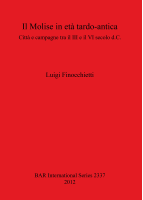Description
BOOK DESCRIPTIONMolise, southern Italy, formerly linked with the region of Abruzzo, has recently attracted further archaeological interest since becoming the newest Italian region in 1963. The history of the discoveries and studies of Late-Antique Molise is a recent one. The history of Roman discoveries in the large Samnitic hinterland begins from the second half of the 19th century. In this period a network of local researchers linked to the Archaeological Institute of Correspondence in Rome (founded in 1829) recorded ad hoc information about ruins and inscriptions that proved most helpful for the newly founded administrative institutions of the new Kingdom of Italy. In the second half of the 20th century the archaeological data concerned not only inscriptions, but also monuments and the urban and rural topography of the Roman-Hellenistic period. Recently, the stratigraphic excavations of the Soprintendenza of Molise, and some university projects, have provided a significant amount of archaeological data about the LateAntique and Early Medieval history of this regional territory (Molise), as presented by the historical and archaeological data. Focusing on Late Antiquity, the author in this study looks specifically at the Roman towns of Larinum, Buca, Terventum, Fagifulae, Aesernia, Bovianum, Venafrum, and Saepinum.











